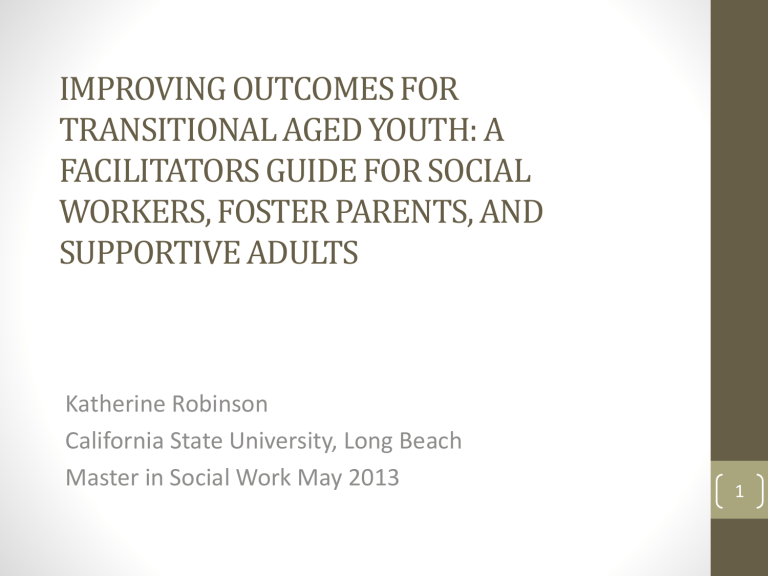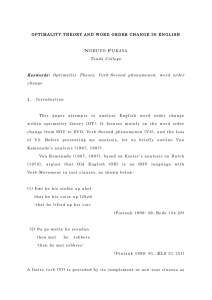Improving Outcomes for Transitional Aged Youth

IMPROVING OUTCOMES FOR
TRANSITIONAL AGED YOUTH: A
FACILITATORS GUIDE FOR SOCIAL
WORKERS, FOSTER PARENTS, AND
SUPPORTIVE ADULTS
Katherine Robinson
California State University, Long Beach
Master in Social Work May 2013
1
Current Practice
• Federally mandated Independent Living Program
• Prepare TAY to enter into adult living
• Teaches hard technical skills such as budgeting, cooking, cleaning, employment skills, and education options.
Problem
• TAY continue to have poor life outcomes (employment, education, housing, and financial) when emancipating from foster care.
• Developmental and emotional skills are not offered and are challenging to implement in a workshop setting.
2
Definition of Terms
• Transitional Aged Youth (TAY): This term refers to youth between the ages of 16 and twenty-five who are or were in the foster care system (McGrew & Danner, 2009).
• Aging Out: This is the process of a youth transitioning from the jurisdiction of the foster care system towards independent living
(Vacca, 2008)
• Independent Living Program (ILP): This is a federally mandated program that is tasked with offering services to adolescent foster youth to prepare them for their exit from the foster care system into self-sufficiency (Lemon et al, 2005).
• Permanency: This term refers to a relationship where the youth feels part of a family system that provides unconditional love, it is continuous, secure, consistent, fulfilling, and permanent (Freundlich et al, 2006).
3
Social Work Relevance
• National Association of Social Workers (NASW) Code of Ethics
• Dignity and self-worth of a person
• Social workers seek to enhance clients’ capacity and opportunity to change and to address their own needs.
• Recognize the importance of human relationships
• seek to strengthen relationships among people in a purposeful effort to promote, restore, maintain, and enhance the wellbeing of individuals, and families.
Continued Case Management through Fostering Connections to
Success Act
• Social Workers continue to case manage TAY through AB 12.
• Learning interactions with Non-Minor Dependents.
• Create meaningful interactions with TAY to develop a interdependent live style.
4
Curriculum
• Facilitator guide for social workers, care givers, mentors, and supportive adults.
• Identify areas of emotional and developmental growth.
• Provide guidelines regarding interactions with the team players and the youth to establish and develop appropriate emotional skills.
• Offer activities that are usable in the home, school, and natural environments to initiate skills development.
5
Topics in Curriculum
• Transitional Aged Youth
• Permanency and Relationships
• Team Building
• Decision Making
• Effective Communication
• Coping Skills
6
Goals of Curriculum
• Increase participants knowledge about TAY.
• Increase participants knowledge about the challenges TAY face when entering adulthood.
• Increase participants ability to communicate effectively with
TAY.
• Increase participants knowledge of resources for TAY.
• Increase participants ability and skills to develop and establish permanency for TAY.
• Develop effective engagement approaches with TAY population
• Develop best practices in assisting TAY during the transition to adulthood.
7
Lessons Learned
• TAY need committed adults to teach and nurture social and emotional development.
• Co-facilitation is the best method of offering the training because the facilitators have experience in working with TAY.
• TAY facilitators offer a wealth of knowledge and experience to share with participants.
• The curriculum could be expanded to a larger audience that interact with TAY (therapists, teachers, and counselors).
• Emotional and social skills are traditionally learned over many years of childhood and in natural settings. However, TAY lack the years of learning and need constant support, guidance, continuity, and patience to develop the skills needed for a positive transition into adulthood.
8
References
• Vacca, J. S. (2008) Foster children need more help after they reach the age of eighteen. Children and Youth Services
Review, 30, 485-492.
• McGrew, J. H., & Danner, M. (2009). Evaluation of an intensive case management program for transition age youth and its transition to assertive community treatment.
American Journal of Psychiatric Rehabilitation, 12(3),
278-294. doi:10.1080/15487760903066503
• Lemon, K., Hines, A. M., & Merdinger, J. (2005). From foster care to young adulthood: The role of Independent Living program in supporting successful transitions. Children
and Youth Services Review, 27, 251-270.
• Freundlich, M., Avery, R., Munson, S., & Gerstenzang, S.
(2006). The meaning of permanency in child welfare:
Multiple stakeholder perspective. Children and Youth
Services Review, 28(7), 741-760.
9











